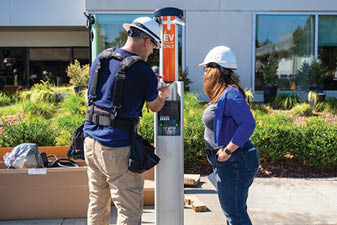|
By Elaine Nessle, Senior Associate,
Blakey & Agnew
This month the U.S. Department of Transportation rolled out a hallmark program included in the $1.2 trillion Infrastructure Investment and Jobs Act (IIJA): electric vehicle (EV) charging infrastructure guidance and funding. A significant stumbling block to the widespread adoption of EVs is the dearth of charging stations across the United States. The IIJA will begin to address this by investing $30 billion in the development of the transportation and grid infrastructure needed to foster EV adoption.
This investment program aligns with the Biden-Harris administration’s climate agenda. According to the U.S. Environmental Protection Agency (EPA), the transportation sector is one of the largest contributors to anthropogenic U.S. greenhouse gas (GHG) emissions, accounting for almost a third of U.S. GHG emissions. Migrating from a fossil fuel fleet to an EV fleet stands to take a big bite out of our country’s GHG emissions.
Not long ago the thought of wide-spread adoption of EVs was akin to the images of the Jetson’s flying car racing along a highway in the sky. Today, just 1 percent of the U.S. passenger vehicle fleet is electric. Now an electric future is knocking on our door and government isn’t the only player moving in this direction. Auto makers are betting big on electric, introducing fewer internal combustion engines and more battery powered vehicles. In early 2021, General Motors announced its goal to cease the production of gasoline powered vehicles by 2035.
In November of 2021, world leaders gathered in Glasgow, Scotland at the 2021 United Nations Climate Change Conference (COP26) and focused on setting emissions reduction targets in an effort to blunt global warming. A host of automakers, cities, and countries signed The Glasgow Declaration on Zero Emission Cars and Vans, pledging to phase out the sale of new fossil fuel powered vehicles by 2040. General Motors, Ford, Volvo Cars, Mercedes-Benz, and Jaguar Land Rover were among the largest manufacturers to sign the pledge. Noticeably absent
|

were top automakers Volkswagen, Toyota, Renault-Nissan, and Hyundai-Kia. An initial leader in the field, Toyota began selling EVs in 1997 but declined to sign the pledge citing, among other factors, the question of charging infrastructure readiness.
Passenger vehicles are just one, albeit large, part of the equation. Just 2 percent of the North American commercial vehicle fleet is electric currently, but a February 7 study by ACT Research predicts the share to be just over 20 percent in five years. The nature of interstate commerce requires coast-to-coast availability of charging infrastructure to enable EV growth in the commercial sector. The IIJA provides a significant chunk of money to state departments of transportation to build out this network.
Is the grid prepared for widespread EV deployment? The answer is complicated. If, for example, the entire U.S. auto fleet were to become electric tomorrow and all EVs charged at the exact same time, then the answer would be “no.” But that’s not reality. According to McKinsey & Company’s auto retail micro-market model, Americans purchase more than double the number of used cars versus new cars each year. Meaning, combustion engine vehicles will continue circulating in the used car market for years to come, contributing to a gradual EV roll out. Further, the IIJA contains funding for utilities to invest in grid modernization. Combined, utilities have the benefit of time and treasure to develop plans and strategies in preparation for this rolling trend.
Blakey & Agnew, LLC is a public affairs and
communications consulting firm based in
Washington, DC.
|


